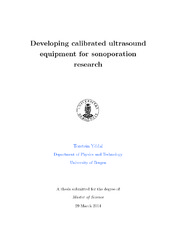Developing calibrated ultrasound equipment for sonoporation research
Master thesis
Permanent lenke
https://hdl.handle.net/1956/9943Utgivelsesdato
2015-03-29Metadata
Vis full innførselSamlinger
Sammendrag
Sonoporation is the transient formation of pores in cells, due to the application of ultrasound or ultrasound in combination with microbubbles. This increases drug uptake. Nevertheless, the ideal parameters for sonoporation have yet to be found. A major problem consists in the fact that near all research is done using different tools, techniques and parameters. In addition it is a translational field, requiring expert knowledge in both physics and biology. In order to accelerate this research, we aim to develop a low cost, easy-to- use tool, simplifying this transition between biology and physics. Two devices were designed using three dimensional (3D) computer aided design (CAD) software, with a focus on being low cost, having a small footprint, portability and compatability with existing biological culture equipment. The devices were subsequently printed using 3D- printing technology, and assembled. Thereafter, the essential part of calibrating the devices was performed in order to determine the performance of the device. Multiple characterization techniques were implemented in order to optimize the performance of the devices, as well as determining ultrasonic pressures. Electrical impedance scans and pulse-echo frequency sweeps were performed to find optimal operational frequencies. Pressure distribution was characterized using 3D free-field hydrophone scans. Power ramps were performed to correlate electrical power input to acoustic pressure output. To improve performance, transmission line transformers were implemented as an electrical impedance matching network. Lastly, to predict the complex interaction with the biological cell culture chambers, four dimensional (4D) simulations were performed. Results showed that by following a strict fabrication protocol, the ultrasound transducers had a variance of less than 1%. The transmission line transformers reduced the electrical reflection coefficient magnitude by a factor up to 2.9 and increased the acoustic power output by a factor of 3.15. Simulations showed that when introducing complex interfaces as seen in cell culture chambers, multiple reflections were created. This resulted in destructive and constructive interference, making the ultrasound field unpredictable". In conclusion, it has been demonstrated that following the protocol described, it was possible to make reliable and reproducible devices that simplify in vitro ultrasound experiments. Nevertheless, the complex interactions with biological equipment have to be evaluated further.
